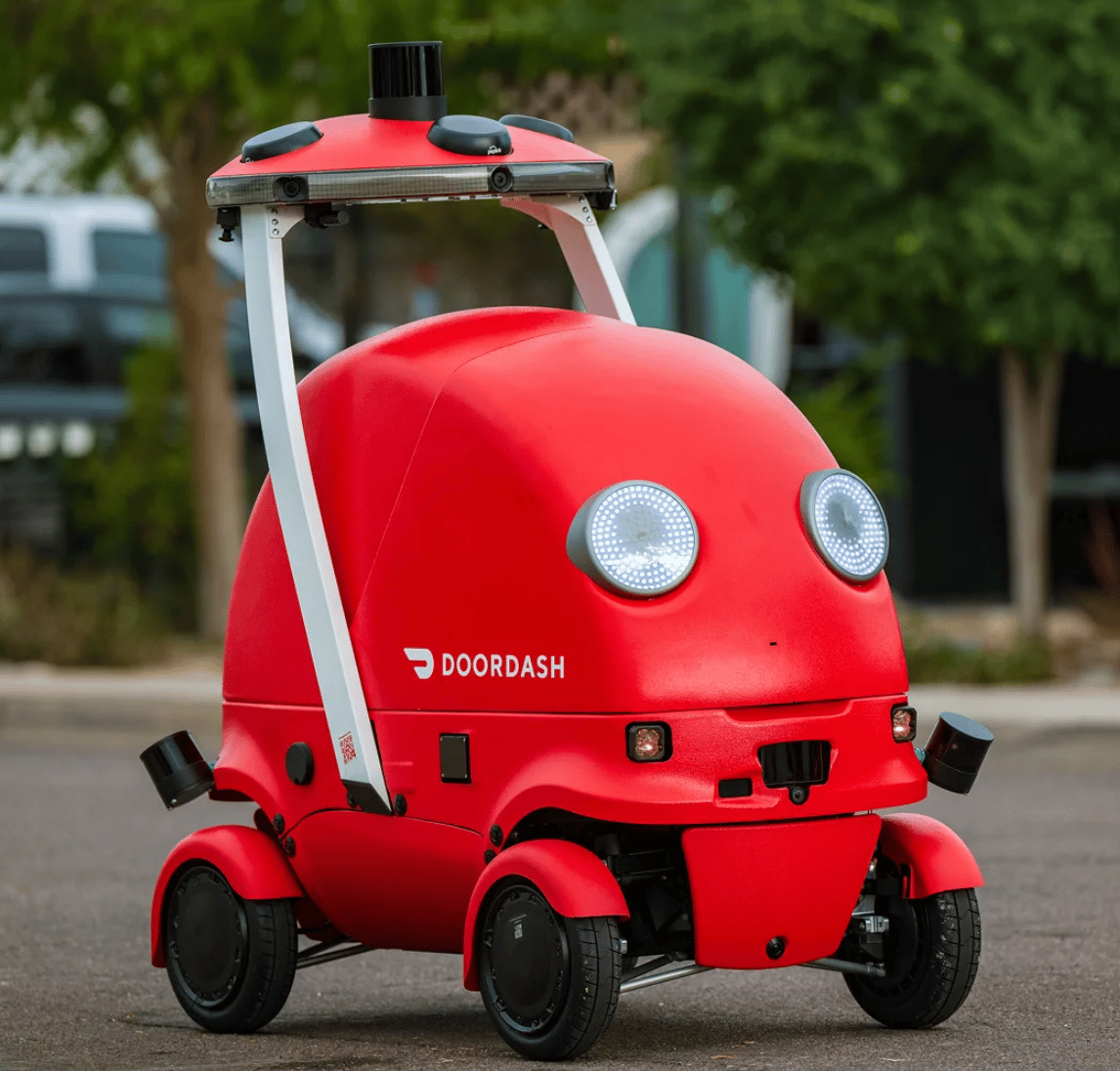On September 30th., DoorDash unveiled Dot - a 350-pound robot travels up to 20 mph on bike lanes, roads, and sidewalks. It's the company's first fully in-house autonomous delivery vehicle.
The timing matters. DoorDash has been working toward this for the last seven years. The company acquired AV startup Scotty Labs in 2019, brought on co-founders from AV mapping startup Lvl 5, and hired Ashu Rege from Amazon's Zoox in 2021 to lead autonomy. This isn't a quick pivot to follow trends. It's been a long build.
The decision to build in-house came from a gap in existing technology. Stanley Tang, DoorDash co-founder and head of DoorDash Labs, said existing autonomous delivery robots couldn't handle DoorDash's use case. Sidewalk robots move too slowly. Car-sized vehicles are overkill for small orders. Nothing could navigate the mix of bike lanes, parking lots, and driveways that DoorDash deliveries require.

DoorDash Dot
Dot stands 4.5 feet tall, weighs 350 pounds, and measures three feet wide. That size is deliberate. Small enough to fit through most doors and on sidewalks. Big enough to be visible to drivers and hard to tip over. One-tenth the size of a car. Can carry up to 30 pounds or six large pizzas.
The robot runs all-electric with swappable batteries that last six to eight hours. The modular interior adapts to different cargo types for restaurants, grocery stores, and convenience stores. Eight cameras and three lidar sensors handle navigation through blocked bike lanes, construction zones, crowded parking lots, and busy streets.
DoorDash tested Dot across millions of simulated and real-world miles. The robot is launching in early access in Tempe and Mesa, Arizona, with plans to reach 1.5 million people by end of 2025. Merchants can start Dot deliveries with no upfront cost.
The business model integrates with DoorDash's new Autonomous Delivery Platform. The system acts as an AI dispatcher, matching each order with the optimal delivery method based on speed, cost, location, and experience. Options include human Dashers, Dot, Wing's drones, Coco Robotics' sidewalk robots, or other autonomous vehicles.
DoorDash emphasizes that human delivery workers will still handle the vast majority of orders. Dot targets simple, repetitive deliveries. The company says this lets Dashers "focus more on the high-value orders that require human judgment and care." Translation: robots get the tube of toothpaste orders, humans handle complex multi-stop pickups and apartment buildings.
The infrastructure required is significant. DoorDash built warehouses to store robots, charging stations for batteries, and hired field operators to clean and rescue Dots when issues arise. Rege declined to disclose headcount or costs for this ecosystem.
Safety and vandalism are real concerns. Waymo robotaxis have been vandalized on city streets. Dot includes a camera inside its cargo space partially to ensure small humans don't climb in. The robot is light enough that a few people could tip it over, but field operators can flip them back upright.
Compare this to competitors. Uber partnered with Israeli drone startup Flytrex for food delivery. Uber Eats also tested deliveries using Waymo's self-driving cars. Both are integration plays, not owned technology. DoorDash is building the full stack.
The company completed over 10 billion deliveries. That dataset informed every design decision. Tang said understanding "the first and last ten feet" of delivery was critical. Most autonomous solutions handle the middle mile well. The pickup from the restaurant and delivery to the customer's door is where complexity lives.
Design lesson: Build your own when existing solutions don't match your use case, but only if you have the data and scale to justify it. DoorDash couldn't buy what it needed because delivery robots were optimized for different constraints. Sidewalk robots prioritize safety over speed. Larger autonomous vehicles work for long-distance but can't navigate tight spaces.
DoorDash analyzed billions of deliveries to understand actual requirements: must fit through restaurant doors, navigate residential driveways, handle weather, operate 6-8 hours on a charge, carry enough for typical orders, move fast enough to maintain food quality. No existing robot hit all these requirements.
The seven-year timeline shows the real cost of building autonomous systems. Quick pivots don't work. The talent acquisition (Scotty Labs, Lvl 5, Zoox leadership), the testing infrastructure, the regulatory conversations, the field operations ecosystem all take years to build.
The market opportunity is massive if it works. DoorDash facilitates millions of deliveries daily. Even capturing 10-20% with autonomous delivery at lower cost per delivery would be significant. But the company is competing against Uber's partnerships, Instacart's automation efforts, and dozens of delivery robot startups.
Early regulatory conversations have been positive, according to Rege. City and state officials see small vehicle delivery as reducing traffic congestion. But regulations vary by geography. What works in Phoenix may not work in San Francisco or New York.
The stakes are high. Countless startups have failed in the autonomous vehicle space. Some faced penalties when their machines caused harm. DoorDash is betting that seven years of preparation, 10 billion deliveries of training data, and purpose-built hardware for a specific use case will succeed where others failed.
DoorDash, September 30, 2025
CNBC, September 30, 2025
TechCrunch, September 30, 2025
Restaurant Dive, October 1, 2025
